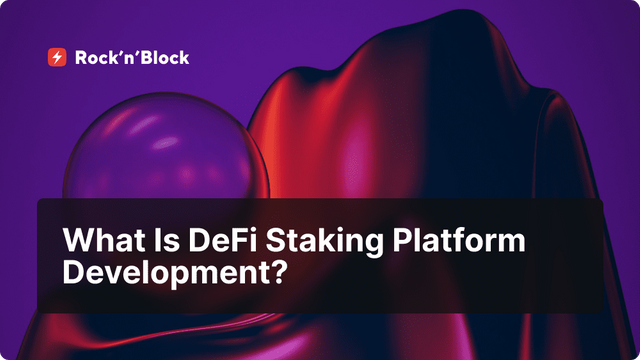The concept of staking platforms has emerged as a cornerstone for crypto projects aiming to innovate and engage users effectively. This comprehensive guide dives deep into the multifaceted world of DeFi staking platform development. From understanding the fundamentals of these platforms to exploring their key features and operational mechanisms, this article provides invaluable insights for crypto projects looking to harness the power of staking. We'll delve into the benefits of DeFi staking platform development, compare staking with farming, and examine essential factors to consider during the development process.

What are DeFi Staking Platforms?
A DeFi staking platform is a decentralized platform providing users the ability to lock up their cryptocurrency assets for a specified period in exchange for rewards. It helps projects incentivize long-term commitment from token holders.
By participating in staking, users contribute to the platform's token supply dynamics while earning rewards based on the amount of assets they stake. By engaging in staking, users actively contribute to the network's integrity and resilience while potentially increasing their holdings through earned rewards. This system not only incentivizes long-term asset retention but also bolsters the overall functionality and sustainability of the platform.
Key Features of DeFi Staking Platforms:
Secure Smart Contracts: Ensure safety through robust contract development, audits, and ongoing security measures.
Intuitive User Experience: Provide a user-friendly interface for easy onboarding, staking, and reward tracking.
Flexible Staking Options: Offer various staking durations, amounts, and reward structures to cater to different users.
Sustainable Tokenomics: Balance rewards, inflation, and token utility to maintain ecosystem health and user incentives.
Interoperability and Integration: Facilitate seamless integration with other DeFi protocols for enhanced liquidity and utility.
Deposits and Withdrawals: Enable swift and transparent transactions with clear fee structures.
Crypto Wallet Integration: Support various wallet types for secure access to staked assets.
Reports: Provide comprehensive reporting tools for performance monitoring and decision-making.
Rewards Calculator: Offer an interactive tool for users to estimate potential earnings based on staking parameters.
Re-Stake Features: Implement auto-compounding and fee optimization for maximizing returns.
Entry/Exit Policies: Define flexible participation options with penalties to encourage long-term commitment and stability.
How DeFi Staking Platforms Work
DeFi staking platforms operate through a simple step-by-step process:
- Connecting a Wallet: Users connect their crypto wallet to the platform for accessing and managing their assets securely.
- Choosing a Staking Asset: Users select the cryptocurrency they want to stake based on factors like rewards and personal strategies.
- Staking Tokens: Users lock up their chosen cryptocurrency within the platform's smart contract.
- Earning Rewards: Users receive additional tokens periodically as rewards for staking, based on factors like duration and amount staked.
- Monitoring and Managing Activities: Users track rewards, monitor performance, and adjust parameters through the platform's interface.
- Withdrawing Staked Tokens: Upon completion of the staking period or user's discretion, staked tokens can be withdrawn back to the wallet, granting full ownership.
Benefits of DeFi Staking Platform Development for Crypto Projects
- Enhanced Token Demand and Value: Staking drives token scarcity and demand, boosting its market appeal and value proposition.
- Community Engagement and Empowerment: Staking makes users active participants, fostering trust, loyalty, and community growth.
- Differentiation and Competitive Advantage: Staking platforms showcase innovation, decentralization, and offer unique value propositions, setting projects apart and attracting investors seeking diverse opportunities in decentralized finance.
Staking vs. Farming: Understanding the Difference
Staking and farming represent two distinct methods for users to earn rewards and engage with networks in the DeFi ecosystem. Understanding the disparity between staking and farming platform development is pivotal for crypto projects aiming to optimize returns and user participation effectively.
Key Differences:
- Purpose: Staking regulates token supply and fosters engagement, while farming maximizes yield through liquidity provision and trading.
- Mechanism: Staking locks tokens in smart contracts, while farming involves LP token locking gained from providing liquidity.
- Risk Level: Staking is generally lower risk, whereas farming can involve higher risks like impermanent loss and protocol changes.
- Reward Type: Staking rewards come in additional tokens, while farming rewards vary, including tokens, fees, or interest.
- User Engagement: Staking encourages long-term holding, fostering loyalty, while farming attracts users seeking short-term optimization, often with less commitment.
Staking and farming platforms offer distinct pathways for engagement and yield generation. By comprehending these differences, crypto projects can tailor strategies to align with objectives and user preferences, driving innovation and growth in DeFi.
Factors to Consider in DeFi Staking Platform Development
Building a successful DeFi staking platform entails considering various factors:
- Security Measures: Prioritize the security of smart contracts and infrastructure through audits, testing, and ongoing assessments to protect users' funds and establish trust.
- Scalability: Ensure the platform can handle increasing transaction volumes and user interactions without sacrificing performance. Utilize scalable blockchain solutions and optimize gas fees for efficient operations.
- Interoperability: Enable seamless integration with other DeFi protocols and platforms to enhance liquidity, accessibility, and utility for users, fostering a more interconnected ecosystem.
The Future of DeFi Staking Platforms
The future of DeFi staking platform development holds great promise for crypto projects. These platforms offer numerous benefits that can push projects forward in the evolving decentralized finance ecosystem. By embracing technological innovation, regulatory compliance, and user-centric design principles, projects can create robust and inclusive staking platforms that empower users to participate in decentralized finance securely and seamlessly. Strategic partnerships and collaborations within the DeFi ecosystem can unlock new opportunities for growth, expansion, and value creation. DeFi staking platform development enables crypto projects to generate revenue, enhance token demand, foster community engagement, and differentiate themselves in a competitive market, positioning them for long-term success and leadership in the evolving landscape of decentralized finance.